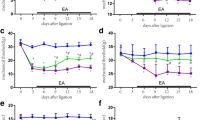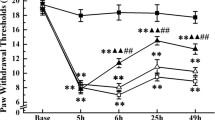Abstract
Objective
To investigate whether analgesic effect of electroacupuncture (EA) is affected by p38 mitogen-activated protein kinase (p38 MAPK) on microglia.
Methods
There were two experiments. The experiment 1: 40 male Sprague-Dawley (SD) rats were randomly divided into the normal, surgery, EA and sham EA groups, and the L5 spinal nerve ligation (SNL) on the right side was used to establish neuropathic pain model. EA was applied to bilateral Zusanli (ST36) and Kunlun (BL60) at 24, 48 and 72 h after SNL for 30 min, once per day. The paw withdrawal thresholds (PWTs) were measured before surgery (as base) and at 24, 25, 49 and 73 h after surgery. Phospho-p38 MAPK (p-p38 MAPK), oxycocin-42 (OX-42, marker of microglia), and glial fibrillary acidic protein (GFAP, marker of astrocyte) in bilateral spinal cord dorsal horn (SCDH) were detected by immunofluorescence, respectively. The experiment 2: 40 male SD rats were cannulated for SNL-induced neuropathic pain, and then were randomly divided into the dimethyl sulfoxide (DMSO), EA plus DMSO, 4-(4-fluorophenyl)-2-(4-methylsulfonylpheny)-5-(4-pyridyl)-1H-imidazole (SB203580) and EA plus SB203580 groups. SB203580 (30 nmol/L) was administered 5 min prior to EA treatment. The PWTs and OX-42 in bilateral SCDH were measured as mentioned above.
Results
SNL-induced neuropathic pain reduced PWTs and increased the expression of p-p38 MAPK and OX-42 in bilateral lumbar SCDH of rats (P<0.01). Spinal p-p38 MAPK was only co-localized with OX-42 in our study. EA treatment significantly alleviated SNL-mediated mechanical hyperalgesia, and suppressed the expression of p-p38 MAPK and OX-42 in lumbar SCDH (P<0.05 or P<0.01). Intrathecal injection of low dose SB203580 had no influence on PWTs (P>0.05), but significantly inhibited the expression of OX-42 positive cells in bilateral SCDH (P<0.01 or P<0.05). EA plus SB203580 synergistically increased PWTs, and reduced the expression of bilateral spinal OX-42 (P<0.01 or P<0.05).
Conclusions
The central mechanism of EA-induced anti-hyperalgesia may be partially associated with the reduced expression of p-p38 MAPK, and subsequently reducing the activation of OX-42 in neuropathic pain. Therefore, EA may be a new complementary and alternative therapy for neuropathic pain.
Similar content being viewed by others
References
Woolf CJ, Mannion RJ. Neuropathic pain: aetiology, symptoms, mechanisms, and management. Lancet 1999;353:1959–1964.
Hwang BG, Min BI, Kim JH, Na HS, Park DS. Effects of electroacupuncture on the mechanical allodynia in the rat model of neuropathic pain. Neurosci Lett 2002;320:49–52.
Fang JQ, Du JY, Liang Y, Fang JF. Intervention of electroacupuncture on spinal p38 MAPK/ATF-2/VR-1 pathway in treating inflammatory pain induced by CFA in rats. Mol Pain 2013;9:13.
Liang Y, Fang JQ, Du JY, Fang JF. Effect of electroacupuncture on activation of p38 MAPK in spinal dorsal horn in rats with complete Freund's adjuvant-induced inflammatory pain. Evid Based Complement Alternat Med 2012;2012:568273.
Fang JF, Liang Y, Du JY, Fang JQ. Transcutaneous electrical nerve stimulation attenuates CFA-induced hyperalgesia and inhibits spinal ERK1/2-COX-2 pathway activation in rats. BMC Complement Altern Med 2013;13:134.
Yamdeu RS, Shaqura M, Mousa SA, Schafer M, Droese J. p38 mitogen-activated protein kinase activation by nerve growth factor in primary sensory neurons upregulates muopioid receptors to enhance opioid responsiveness toward better pain control. Anesthesiology 2011;114:150–161.
Sorkin L, Svensson CI, Jones-Cordero TL, Hefferan MP, Campana WM. Spinal p38 mitogen-activated protein kinase mediates allodynia induced by first-degree burn in the rat. J Neurosci Res 2009;87:948–955.
Zheng F, Xiao WH, Bennett G. The response of spinal microglia to chemotherapy-evoked painful peripheral neuropathies is distinct from that evoked by traumatic nerve injuries. Neuroscience 2011;176:447–454.
Zhang H, Nei H, Dougherty PM. A p38 mitogen-activated protein kinase-dependent mechanism of disinhibition in spinal synaptic transmission induced by tumor necrosis factor-alpha. J Neurosci 2010;30:12844–12855.
Ji RR, Gereau RWt, Malcangio M, Strichartz GR. MAP kinase and pain. Brain Res Rev 2009;60:135–148.
Hains BC, Waxman SG. Activated microglia contribute to the maintenance of chronic pain after spinal cord injury. J Neurosci 2006;26:4308–4317.
Xu JT, Xin WJ, Wei XH, Wu CY, Ge YX, Liu YL, et al. p38 activation in uninjured primary afferent neurons and in spinal microglia contributes to the development of neuropathic pain induced by selective motor fiber injury. Exp Neurol 2007;204:355–365.
Wen YR, Suter MR, Kawasaki Y, Huang J, Pertin M, Kohno T, et al. Nerve conduction blockade in the sciatic nerve prevents but does not reverse the activation of p38 mitogenactivated protein kinase in spinal microglia in the rat spared nerve injury model. Anesthesiology 2007;107:312–321.
Ledeboer A, Sloane EM, Milligan ED, Frank MG, Mahony JH, Maier SF, et al. Minocycline attenuates mechanical allodynia and proinflammatory cytokine expression in rat models of pain facilitation. Pain 2005;115:71–83.
Lin CS, Tsaur ML, Chen CC, Wang TY, Lin CF, Lai YL, et al. Chronic intrathecal infusion of minocycline prevents the development of spinal-nerve ligation-induced pain in rats. Reg Anesth Pain Med 2007;32:209–216.
Sun S, Mao-ying QL, Cao H, Li TT, Han M, Pan HL, et al. Is functional state of spinal microglia involved in the anti-allodynic and anti-hyperalgesic effects of electroacupuncture in rat model of monoarthritis? Neurobiol Dis 2007;26:558–568.
Gim GT, Lee JH, Park E, Sung YH, Kim CJ, Hwang WW, et al. Electroacupuncture attenuates mechanical and warm allodynia through suppression of spinal glial activation in a rat model of neuropathic pain. Brain Res Bull 2011;86:403–411.
Cui Y, Chen Y, Zhi JL, Guo RX, Feng JQ, Chen PX. Activation of p38 mitogen-activated protein kinase in spinal microglia mediates morphine antinociceptive tolerance. Brain Res 2006;1069:235–243.
Jin SX, Zhuang ZY, Woolf CJ, Ji RR. p38 mitogen-activated protein kinase is activated after a spinal nerve ligation in spinal cord microglia and dorsal root ganglion neurons and contributes to the generation of neuropathic pain. J Neurosci 2003;23:4017–4022.
Huang C. MAP kinases and cell migration. J Cell Sci 2004;117:4619–4628.
Hua XY, Svensson CI, Matsui T, Fitzsimmons B, Yaksh TL, Webb M. Intrathecal minocycline attenuates peripheral inflammation-induced hyperalgesia by inhibiting p38 MAPK in spinal microglia. Eur J Neurosci 2005;22:2431–2440.
Xu F, Li T, Zhang B. An improved method for protecting and fixing the lumbar catheters placed in the spinal subarachnoid space of rats. J Neurosci Methods 2009;183:114–118.
Yong HY, Koh MS, Moon A. The p38 MAPK inhibitors for the treatment of inflammatory diseases and cancer. Expert Opin Investig Drugs 2009;18:1893–1905.
Sorkin L, Svensson CI, Jones-Cordero TL, Hefferan MP, Campana WM. Spinal p38 mitogen-activated protein kinase mediates allodynia induced by first-degree burn in the rat. J Neurosci Res 2009;87:948–955.
Landry RP, Martinez E, DeLeo JA, Romero-Sandoval EA. Spinal cannabinoid receptor type 2 agonist reduces mechanical allodynia and induces mitogen-activated protein kinase phosphatases in a rat model of neuropathic pain. J Pain 2012;13:836–848.
Clark AK, Yip PK, Grist J, Gentry C, Staniland AA, Marchand F, et al. Inhibition of spinal microglial cathepsin S for the reversal of neuropathic pain. Proc Natl Acad Sci U S A 2007;104:10655–10660.
Tsuda M, Mizokoshi A, Shigemoto-Mogami Y, Koizumi S, Inoue K. Activation of p38 mitogen-activated protein kinase in spinal hyperactive microglia contributes to pain hypersensitivity following peripheral nerve injury. Glia 2004;45:89–95.
Tong SE, Daniels SE, Black P, Chang S, Protter A, Desjardins PJ. Novel p38alpha mitogen-activated protein kinase inhibitor shows analgesic efficacy in acute postsurgical dental pain. J Clin Pharmacol 2012;52:717–728.
Anand P, Shenoy R, Palmer JE, Baines AJ, Lai RY, Robertson J, et al. Clinical trial of the p38 MAP kinase inhibitor dilmapimod in neuropathic pain following nerve injury. Eur J Pain 2011;15:1040–1048.
Ji RR, Berta T, Nedergaard M. Glia and pain: is chronic pain a gliopathy? Pain 2013;154(Suppl 1):S10–S28.
Piao ZG, Cho IH, Park CK, Hong JP, Choi SY, Lee SJ, et al. Activation of glia and microglial p38 MAPK in medullary dorsal horn contributes to tactile hypersensitivity following trigeminal sensory nerve injury. Pain 2006;121:219–231.
Miyoshi K, Obata K, Kondo T, Okamura H, Noguchi K. Interleukin-18-mediated microglia/astrocyte interaction in the spinal cord enhances neuropathic pain processing after nerve injury. J Neurosci 2008;28:12775–12787.
Ji RR, Suter MR. p38 MAPK, microglial signaling, and neuropathic pain. Mol Pain 2007;3:33.
Griffin RS, Costigan M, Brenner GJ, Ma CH, Scholz J, Moss A, et al. Complement induction in spinal cord microglia results in anaphylatoxin C5a-mediated pain hypersensitivity. J Neurosci 2007;27:8699–8708.
Zhuang ZY, Gerner P, Woolf CJ, Ji RR. ERK is sequentially activated in neurons, microglia, and astrocytes by spinal nerve ligation and contributes to mechanical allodynia in this neuropathic pain model. Pain 2005;114:149–159.
Svensson CI, Fitzsimmons B, Azizi S, Powell HC, Hua XY, Yaksh TL. Spinal p38beta isoform mediates tissue injuryinduced hyperalgesia and spinal sensitization. J Neurochem 2005;92:1508–1520.
Katsura H, Obata K, Mizushima T, Sakurai J, Kobayashi K, Yamanaka H, et al. Activation of Src-family kinases in spinal microglia contributes to mechanical hypersensitivity after nerve injury. J Neurosci 2006;26:8680–8690.
Svensson CI, Schafers M, Jones TL, Powell H, Sorkin LS. Spinal blockade of TNF blocks spinal nerve ligation-induced increases in spinal p-p38. Neurosci Lett 2005;379:209–213.
Boyle DL, Jones TL, Hammaker D, Svensson CI, Rosengren S, Albani S, et al. Regulation of peripheral inflammation by spinal p38 MAP kinase in rats. PLoS Med 2006;3:e338.
Won KA, Kang YM, Lee MK, Park MK, Ju JS, Bae YC, et al. Participation of microglial p38 MAPK in formalin-induced temporomandibular joint nociception in rats. J Orofac Pain 2012;26:132–141.
Chang YW, Waxman SG. Minocycline attenuates mechanical allodynia and central sensitization following peripheral second-degree burn injury. J Pain 2010;11:1146–1154.
Huang C, Huang ZQ, Hu ZP, Jiang SZ, Li HT, Han JS, et al. Electroacupuncture effects in a rat model of complete Freund's adjuvant-induced inflammatory pain: antinociceptive effects enhanced and tolerance development accelerated. Neurochem Res 2008;33:2107–2111.
Zhou GB, Ma WT, Yu W, Guo AL, Ji JQ. Effect of electroacupuncture on pain threshold and spinal NR2B subunit expression in a rat model of neuropathic pain. J Southern Med Univ 2010;30:2702–2704.
Zhang RX, Li A, Liu B, Wang L, Xin J, Ren K, et al. Electroacupuncture attenuates bone-cancer-induced hyperalgesia and inhibits spinal preprodynorphin expression in a rat model. Eur J Pain 2008;12:870–878.
Meng X, Zhang Y, Li A, Xin J, Lao L, Ren K, et al. The effects of opioid receptor antagonists on electroacupunctureproduced anti-allodynia/hyperalgesia in rats with paclitaxelevoked peripheral neuropathy. Brain Res 2011;1414:58–65.
Gao Y, Chen S, Xu Q, Yu K, Wang J, Qiao L, et al. Proteomic analysis of differential proteins related to anti-nociceptive effect of electroacupuncture in the hypothalamus following neuropathic pain in rats. Neurochem Res 2013;38:1467–1478.
Author information
Authors and Affiliations
Corresponding author
Additional information
Supported by National Natural Science Foundation of China (No. 81102643), Zhejiang Provincial Natural Science Foundation (No. Y2091151), State Administration of Traditional Chinese Medicine (Acupuncture) of Key Subjects Construction Funding (No. [2009]30), and Research Fund of Zhejiang Provincial First-Foremost Key Subject—Acupuncture and Moxibustion (No. [2008]255)
Rights and permissions
About this article
Cite this article
Liang, Y., Du, Jy., Qiu, Yj. et al. Electroacupuncture attenuates spinal nerve ligation-induced microglial activation mediated by p38 mitogen-activated protein kinase. Chin. J. Integr. Med. 22, 704–713 (2016). https://doi.org/10.1007/s11655-015-2045-1
Received:
Published:
Issue Date:
DOI: https://doi.org/10.1007/s11655-015-2045-1




